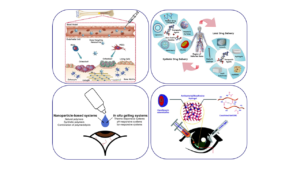Drug/Protein/Gene Delivery
One aspect of our research is designing multifunctional biomolecule-based delivery platforms by combining our knowledge of biomaterials with nanotechnology, and microfabrication techniques. In our research, we aim to engineer different hydrogel-based biomaterials that can be used as advanced technologies for controlled delivery/release applications. We mainly focus on the delivery of biomolecules such as genes/proteins, drugs, and antimicrobial agents for different biomedical applications (i.e., immunomodulation, wound healing, and ocular ulcers and diseases). These biomolecules can be directly loaded into the hydrogel carrier or can be incorporated into nanoparticles to enable the controlled release. We can optimize the biomolecule loading efficiency, delivery, and release by tuning the hydrogels’ physical or biochemical properties. For example, the mesh size of hydrogels significantly influences the rate at which pharmaceutical ingredients diffuse inside or outside the hydrogel network. Another example is by controlling the degradation rate of the hydrogel carrier, which subsequently results in a tunable release profile. In addition, nanoparticles based on biocompatible and biodegradable polymers are popular carriers for drug delivery purposes, since they offer high loading efficiency, precise control over release rate, and can degrade into non-toxic components and be eliminated via the metabolic pathway. It is also well known that the physicochemical properties of the encapsulated biomolecule substance contribute to the release rate. In our lab, we take advantage of these properties to develop advanced hydrogel/nanomaterials-based delivery systems for localized delivery of biological active cues with minimal systemic toxicity.

Lab members working in this area: Yuting Zheng, Yavuz Oz
Related Papers:
- X. Chen, S. Gholizadeh, M. Ghovvati, Z. Wang, M. J. Jellen, A. Mostafavi, R. Dana, N. Annabi, Engineering a drug eluting ocular patch for delivery and sustained release of anti-inflammatory therapeutics, American Institute of Chemical Engineers Journals, 2023, 69:e18067.
- S. Gholizadeh, Z. Wang, X. Chen, R. Dana, N. Annabi, Advanced nanodelivery platforms for topical ophthalmic drug delivery, Drug Discovery Today, 2021, 26, 6, 1437-1449.
- F. Ordikhani, N. Zandi, M. Mazaheri, G. A. Luther, M. Ghovvati, A. Akbarzadeh, N. Annabi, Targeted nanomedicines for the treatment of bone disease and regeneration, Medicinal Research Reviews, 2021, 41, 1221–1254.
- L. Jiang, S. Jung, J. Zhao, V. Kasinath, T. Ichimura, J. Joseph, P. Fiorina, A. S. Liss, K. Shah, N. Annabi, N. Joshi, T. O. Akama, J. S. Bromberg, M. Kobayashi, K. Uchimura, R. Abdi, Simultaneous targeting of primary tumor, draining lymph node, and distant metastases through high endothelial venule-targeted delivery, Nano Today, 2021, 36, 101045.
- S. V. Moghaddam, F. Abedi, E. Alizadeh, B. Baradaran, N. Annabi, A. Akbarzadeh, S. Davaran, Lysine-embedded cellulose-based nanosystem for efficient dual-delivery of chemotherapeutics in combination cancer therapy, Carbohydrate Polymers, 2020, 250, 116861.
- C. Jumelle, S. Gholizadeh, N. Annabi, R. Dana, Advances and limitations of drug delivery systems formulated as eye drops, Journal of Controlled Release, 2020, 321, 1-22.
- I. A. Khalil, B. Saleh, D. M. Ibrahim, C. Jumelle, A. Yung, R. Dana, N. Annabi, Ciprofloxacin-loaded bioadhesive hydrogels for ocular applications, Biomaterials Science, 2020, 8, 18, 5196-5209.
- N. Zandi, E. Mostafavi, M. A. Shokrgozar, E. Tamjid, T. J. Webster, N. Annabi, A. Simchi, Biomimetic proteoglycan nanoparticles for growth factor immobilization and delivery, Biomaterials Science, 2020, 8, 4, 1127-1136.
- M. Uehara, B. Bahmani, L. Jiang, S. Jung, N. Banouni, V. Kasinath, Z. Solhjou, Z. Jing, F. Ordikhani, M. Bae, J. Clardy, N. Annabi, M. M. McGrath, R. Abdi, Nanodelivery of mycophenolate mofetil to the organ improves chronic rejection, ACS Nano, 2019, 13, 11, 12393.
- B. Saleh, H. K. Dhaliwal, R. Portillo‐Lara, E. S. Sani, R. Abdi, M. M. Amiji, N. Annabi, Local immunomodulation using an adhesive hydrogel loaded with miRNA‐laden nanoparticles promotes wound healing, Small, 2019, 15, 36, 1902232.